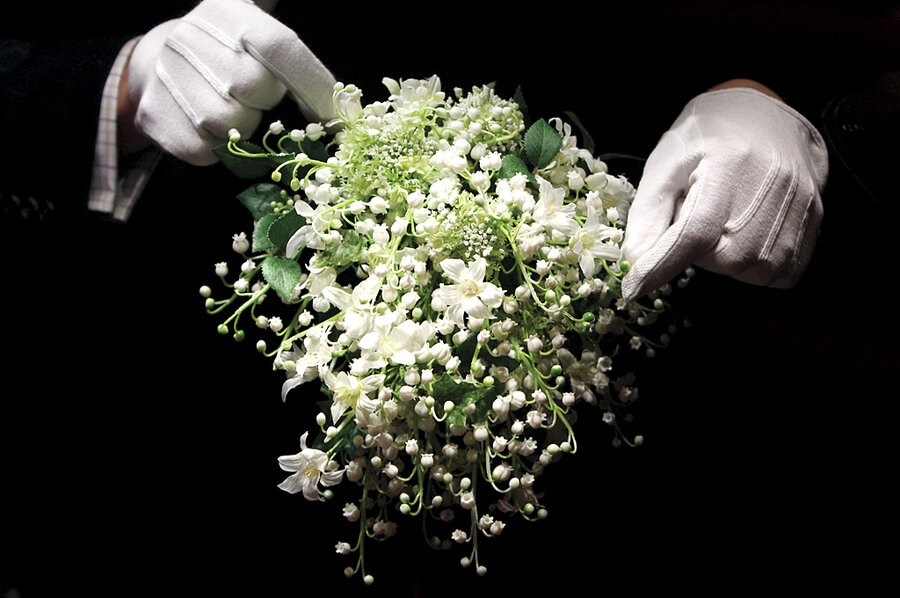Will Pinterest ruin your wedding?
Loading...
There are certain things no one tells you when you start planning a wedding.
No one mentions that much of the process – booking vendor appointments, e-mailing color swatches, creating complex Excel spreadsheets of guest lists, sending out piles of mail – is a lot like having a second job as a receptionist. No one tells you that the economics of buying a wedding dress are roughly the same as buying a car: The more features you add (lace, beading, skirt volume), the bigger the price tag. And no one warns you how quickly Pinterest and other image-sharing sites stocked with beautiful ideas can turn your special day into a money pit.
The average US wedding already cost $28,427 last year, up 5 percent from 2011 and the highest since 2008, according to an annual survey of 17,500 couples released in March by wedding website TheKnot.com. That includes a huge range of budgets, from a $200,000 soiree in a swanky hotel to $5,000 nuptials with a fried-chicken picnic reception. Lately, though, wedding planners and industry experts have started to notice a pattern: a widening gap between brides' expectations and what their budget can actually get them.
The growing popularity of those image-sharing sites plays a role in widening that gap. "A big shift is access to inspiration," says Anja Winnika, site director of TheKnot.com. "Info you would have only gotten through wedding professionals is now readily available on a ton of sites."
Browsing such sites for the perfect gown or centerpiece is akin to shopping in stores with no price tags.
"Because everyone can see the same images, they want the same standard without regard to what their financial situation is," says Fabienne Laveau, a wedding planner and florist who has worked weddings around Washington, D.C., for 10 years. More than ever, she adds, her job involves being an "expectations wrangler, very careful to couch everything in reality."
Fast-growing Pinterest, where users "pin" images on virtual bulletin boards in various categories, has grown to 48.7 million users in just three years, and around 80 percent are women. The most popular age range is 25 to 34, and its wedding boards are hugely popular, driving a bonanza of referral traffic to industry folks who know how to use it.
"It's now our biggest traffic driver, and it's now [referred] more traffic than Facebook has" in five years, says Meg Keene, founder and editor of the popular blog "A Practical Wedding" and author of a book of the same name. "The wedding industry has always been focused on details, because that's what you can sell.... With Pinterest, it's been ramped up."
Cost-wise, those tiny details can add up very quickly. However, when used responsibly, Pinterest has the potential to be an invaluable tool for brides and industry professionals alike.
"It's a great way to communicate," says Ms. Laveau, who uses shared boards to collaborate with clients – each can see what the other is pinning. "It keeps me very in line with what brides want. 'Purple' can mean 50 different things, or she could say 'peonies' when she means 'roses.' "
Plus, amid the array of calligraphic place cards and do-it-yourself Mason jar lanterns, there are useful tips floating around Pinterest, Ms. Keene points out. She recommends finding one practical pin for every flight of fancy – an image of a $3,000 designer gown paired with tips on how to save on a dress, for example.
And make narrowing things down a priority: "Sometimes I have separate boards for every single possible idea, and then one for ideas that I'm actually going to use. That way, you can weed ideas out without feeling like you're getting rid of them," she adds. She also advises thinking about how your pins fit into a larger vision, rather than as a series of self-contained images. "Look more holistically at what you're pinning and see if it's taking you to a crazy place or a helpful place."
Finally, remember that image-driven sites in their current form are a good starting point, but when it gets down to the actual business of booking vendors and writing checks, they aren't much help. Not yet, at least.
But there's "definitely going to be a correction there," says Ms. Winnika of TheKnot.com. "Part of the problem is that weddings are so local, and prices really do vary across the country. But eventually we'll get to the point where brides can access that information" to go along with the images they're falling in love with.
• Ms. Velasco is planning for her wedding in October.








